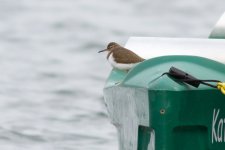Friday 17th April 1430-1845
A bout of chickenpox for my eldest meant neither a day twitch to Bryher or an early start at Upton. When I rocked up to the reserve mid afternoon I was full of hope but it was soon clear that the biting ENE wind had put pay to much movement.
MOORS POOL
2 Lapwing, 4 Oystercatcher, 65 Tufted Duck, 8 Shoveler, 2 Shelduck, 1 Teal (m), 2 Gadwall (pair), 46 Coot, 9 Moorhen, 4 GC Grebe, 4 Little Grebe, 1 Little Egret, 1 Grey Heron, 1 Cormorant, 3 Greylag Geese, 19 Canada Geese, 2 Mute Swan, c200 BH Gull, 2 LBB Gull, 1 Herring Gull, Med Gull (second summer), 3 singing Cetti's Warbler, 1 singing Blackcap, a few Reed and Sedge Warblers, 2 Kingfisher, flock of c65 hirudines (approx. 30 Sand Martin, 25 House Martin & 10 Swallow), Buzzard, Sparrowhawk.
Earlier Whitethroat near the car park as per Mike Jeeves
NORTH MOORS
1 Coot, 4 Teal (3m,1f), 5 Mallard, 4 singing Blackcap, silent Willow Warbler at eastern entrance to loop path
SAILING POOL
2 Common Sandpiper, 3 Mute Swan (all look like last year's young), 2 Canada Geese (plus a further 14 in the fields), 7 GC Grebe, 18 Tufted Duck, 7 Coot, 1 Moorhen, a few more hirudines, Mallard brood with 6 young, Blackcap singing, Cetti's Warbler singing from the Education Reserve
FLASHES - Andy P's extra counts from this morning in []
26[28] Avovet, [Snipe], 2[4] Oystercatcher, 3 LR Plover, 8 Lapwing (still much display activity :t::t

, 1 Common Sandpiper, 21 Coot, 18 Moorhen, 3[4] Gadwall, 2[4] Shelduck, 6 Teal, 3 Shoveler, 11 Tufted Duck, [Little Egret], 2 Canada Geese, 2 LBB Gull, c300 BH Gull, Med Gull (2s) briefly, Willow Warbler singing by the steps, Raven, Buzzard, Cetti's Warbler singing from the Hen Brook






